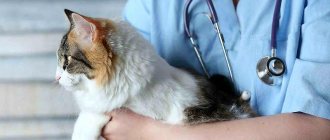Cats are among the most common pets. People are attracted to their intelligence, beauty and sociability. A loving owner does everything to ensure that his cat lives in comfortable conditions. In response, the mustachioed friend gives the person all his love and affection.
Unfortunately, there are also less pleasant consequences of dealing with mustaches. We are talking about cat diseases that can be transmitted to people. Each family member should understand this and carefully monitor the health of the pet in order to prevent unpleasant cases of infection.
Cat diseases dangerous to humans
Veterinarians and experienced felinologists constantly conduct seminars to explain to owners the risks of zooanthroponotic pathologies and the need to prevent infectious diseases contagious to humans, but there are still many myths about the exaggerated danger of cats for humans.
There is a high risk of people developing the following diseases:
- rabies;
- ringworm;
- helminthic infestation.
Separately, it is worth explaining the situation with chlamydia and tuberculosis. Cats, like people, can suffer from this pathology, but the routes of infection differ among species. The structure of the immune system also differs.
Homo sapiens are more susceptible to some infections, cats are more susceptible to others.
For example, tuberculosis occurs more often and in a more severe form in humans, and cats do not tolerate toxoplasmosis well, which is asymptomatic in humans. And only rabies and lichen cause the same pattern of damage in both species.
Anemia
It occurs mainly during the period when the body is infected with parasites that can cause disorders of the circulatory system. An animal can become infected through the bites of blood-sucking insects or infected cats. For humans, such a disease is not considered particularly dangerous, but one can become infected during a general decline in the immune system. The main symptoms of feline anemia in animals are:
- lethargy;
- accelerated breathing;
- very low level of hemoglobin in the blood;
- cardiopalmus;
- reddish color of urine (indicates blood impurities);
- yellowness of the mucous membranes, including the eyes.
Diagnosing feline anemia is quite simple. General clinical blood and urine tests are sufficient. Treatment of animals requires an integrated approach. The prognosis is usually positive: all animals make a full recovery.
In humans, anemia manifests itself in the same way as in a pet - pale skin, nausea, weakness, low blood pressure, fainting. In most cases, it can be cured in just a few weeks.
Danger of scratches
A person can become infected from a cat with a rare form of fever - felinosis. Its causative agents, Bartonella henselae and Bartonella quintana, enter the body through scratches on the skin and are found in saliva, urine, and on the paws and claws of the animal.
Redness and papules appear on the affected areas. Most often, the disease is asymptomatic; in rare cases, inflammation of the lymph nodes and fever occurs, and sometimes conjunctivitis develops.
If the disease has a mild form, then usually the person’s immune system copes with the infection itself. In case of complications, adequate and timely treatment (erythromycin, tetracycline) leads to rapid recovery.
There will be no re-infection; a person will develop a strong immunity.
It is almost impossible to determine whether a cat is a carrier of Bartonella. Externally, the pathology manifests itself in the form of a slight decrease in activity and enlargement of the lymph nodes.
Toxoplasmosis
A person can become infected with toxoplasmosis (an infectious disease) through saliva, or by cleaning the litter box after a pet. The cats themselves become carriers of the causative agent of the disease - the bacterium Toxoplasma gondii, as a result of consuming or hunting birds and rodents.
As a rule, the disease does not manifest itself in any way in either pets or people. Basically, the disease does not have serious consequences for the life and health of the owner. However, toxoplasmosis is extremely dangerous for pregnant women. Various pathologies of fetal development and even fetal death are the most likely consequences of the disease in a pregnant woman.
Symptoms that appear in this case:
- inflammation of the eye membranes;
- a sharp increase in body temperature;
- excessive weight loss and even exhaustion;
- respiratory dysfunction;
- malfunction of the digestive tract.
It is impossible to prevent this disease, because there is no effective vaccine. Both animals and people can get this infection only once in their lives. After the first contact with the pathogen, stable natural immunity is developed for life.
Worm infestation
Young children are most at risk.
Not all types of helminths are dangerous. Diseases that can develop in humans when infected with parasites from a cat:
- toxacarosis (roundworm);
- dipylidia (cucumber tapeworm);
- echinococcosis.
Symptoms of the disease:
- dyspeptic symptoms;
- diarrhea;
- pain in the intestines and stomach;
- rashes on the body;
- loss of appetite, apathy;
- cough and fever.
Infection can occur through saliva or feces of a sick cat.
Signs of parasite infection in pets and humans have a common picture. But the animal usually quickly acquires an unsightly appearance (dull, oily coat) and loses weight.
In order to prevent infection, it is necessary to take preventive measures in a timely manner.
If the disease has already occurred, you should immediately seek medical help. In its most severe form, a person experiences echinococcosis, which without proper treatment can cause internal bleeding. With proper and timely treatment, complete recovery occurs.
Felinosis
The causative agent of the disease is transmitted to the cat from infected rodents and birds. Felinosis (cat scratch disease) is not dangerous for furry pets and sometimes is not accompanied by any symptoms. The disease poses a serious threat to people (especially small children), since bacteria that have penetrated into the human epidermis provoke severe suppuration of the skin. Signs of felinosis in humans are:
- frequent headaches;
- feverish state (sometimes lasting more than a week);
- redness of the affected area, followed by swelling and suppuration;
- enlarged lymph nodes.
To treat people from felinosis, only antimicrobial drugs are used.
Ringworm
This is a highly contagious disease. Domestic cats are at risk of catching it from stray animals. A person can become infected simply by petting a sick pet.
The pathogens - Microsporon, Trichophyton - are anthropozoonotic, that is, common to both.
When affected by this fungal infection, redness, peeling, and purulent lesions usually form on the skin of the hands, head and face. Without timely treatment, the affected area grows and hair loss occurs.
A person can bring the fungus into the house on their shoes or hands if they pet a sick street cat.
It is often difficult to determine who the primary and secondary sources of infestation are in a home. Cats, due to their healthy immunity, sometimes act as carriers of ringworm without contracting it themselves.
This fungal infection requires long and persistent treatment. At the first signs of infection, you should immediately contact a specialist.
Modern diagnostic methods make it possible to immediately identify the pathogen and begin active therapy. The prognosis is favorable, lichen is completely cured. To prevent infection of pets and people, preventive measures must be followed.
How to avoid infecting an animal yourself?
The owner himself can become a source of infection for his furry friend. Therefore, if one of the people around the pet feels unwell, then you should not pick up the cat and leave it on your bed. This can be dangerous for your pet.
Another possibility of bringing infection into the home is when a person comes into contact with sick pets of friends or with homeless individuals. The desire to pet a friend's cat or feed a stray pussy can result in bacteria remaining on your hands that are dangerous for the couch potato.
Sometimes there are cases of infection of cats that do not go outside through human clothing or shoes to which pathogens have attached. In this regard, it is important to put outerwear and shoes in closets and drawers to reduce the contact of a curious cat with outdoor things. It’s a good idea to wash your hands not only after interacting with your furry couch potato, but also before contacting him.
Rabies
This is one of the most terrible diseases in the world, as it is incurable. The only way to protect yourself is to regularly vaccinate domestic and stray animals.
The rabies virus is contained in the saliva of a sick animal. It is transmitted by a bite or contact with scratches and microcracks in the skin.
The disease in humans occurs in two forms. Can be paralytic and violent. If you suspect infection, you must immediately contact a medical facility and undergo a course of vaccinations. Success depends on timely treatment - immediately after the bite.
There are three forms in cats - atypical, violent and hidden.
Symptoms of rabies in a cat:
- unusual animal behavior;
- refusal of food and water;
- vomiting and diarrhea;
- hydrophobia and photophobia;
- desire for isolation;
- rapid intensification of all signs;
- muscle paralysis.
The rabis virus infects the mammalian brain and causes inflammation, which rapidly develops, affecting the entire nervous system. Death usually occurs from paralysis of the respiratory system.
No attempt is made to treat a sick animal; it is immediately euthanized, and the body is subject to cremation.
Other diseases
In addition to the most common, there are other anthropozoonotic diseases; cases of these infections are much less common.
Toxoplasmosis
It is also provoked by protozoa - Toxoplasma.
It poses the greatest threat to pregnant women; it can lead to the development of fetal pathologies and miscarriage.
The symptoms resemble the onset of acute respiratory viral infection, enlargement of the lymph nodes occurs, fever and conjunctivitis occur. Infection occurs during an acute illness of the animal through feces, if they have been in the litter tray for a long time (3-5 days) and through mucous discharge from the nose.
In the chronic form of the disease, the cat is not contagious to humans. Pets are infected with Toxoplasma through raw meat. The disease requires immediate treatment, the prognosis for the person is favorable.
The acute form of the disease is a common cause of death in small kittens and young animals.
Scabies
The causative agent of the disease is the scabies mite. Signs in a cat are revealed during an external examination. Areas of flaky skin and bald patches appear on the body.
It is extremely rare for a person to become infected. But if itching, rash and peeling of the skin appear, you should immediately consult a doctor; timely therapy can quickly cope with the disease.
Salmonellosis
Cases of infection from a pet are extremely rare.
The general symptoms of the disease are fever, abdominal pain, diarrhea and vomiting. This is a serious disease, but it can be successfully treated with timely consultation with a doctor. Cats are usually infected by eating raw meat.
Aujeszky's disease
This disease of mammals is characterized by damage to the central nervous system. Its symptoms in pets are drooling, loss of coordination of movements, outbursts of aggression, itching of the skin.
Animals become infected through infected meat and often die. The disease is transmitted to humans by airborne droplets and manifests itself in itchy skin and increased body temperature.
With timely treatment, the prognosis is favorable.
Tularemia
This severe bacterial disease is transmitted by insects that usually parasitize the corpses of rodents, and in the warm season - by blood-sucking insects.
A person can become infected from a pet through any household contact. The disease in mammals develops rapidly, and the infectious period is also short. The lymph nodes, respiratory system and spleen are affected.
It is rare and there is no vaccine.
At the first signs of infection, active therapy should be started immediately under the supervision of a physician.
Tuberculosis
The causative agent of the infection is Koch's bacillus. A pet becomes infected with the disease after consuming milk and raw meat of an infected animal, as well as through contact with sick relatives. For cats, tuberculosis is almost always fatal. The infection is considered dangerous for humans, as it affects the respiratory system and destroys the immune system. You can determine that an animal has tuberculosis by the following signs:
- the cat often sneezes and coughs;
- the animal looks lethargic and apathetic;
- there are disturbances in the digestive process;
- Hard nodules appear in the head and neck area.
People become infected from their pets if personal hygiene rules are not followed.
Preventive measures
A person can easily prevent any anthropozoonotic diseases by following simple rules.
Deworming
Your pet must be dewormed promptly, at least once every three months. This simple procedure is carried out independently. The cat must be given a special tablet or suspension and the threat of infection with many unpleasant diseases caused by parasites will be prevented.
Annual vaccination
It is one of the main methods of combating anthropozoonotic diseases:
- Pets must be vaccinated against rabies annually. In many public veterinary clinics, Nabivak-rabis injections are given free of charge. This disease, terrible not only for cats, but also for people, has now been practically eradicated from the world. Sometimes its local foci flare up, the causative agents of which are wild animals - foxes, rodents. Universal vaccination helped to cope with the disease. People who work with animals year-round can also get a rabies vaccination once a year.
- Vaccinating your cat against common feline viral infections is also necessary. Although they are not dangerous to humans, they indirectly help maintain their health. After all, if an animal is weakened, it will easily catch a disease that is dangerous to humans.
- Ringworm can also be prevented with special vaccinations. They are not mandatory until they are proven to be 100% effective.
Treatment for external parasites
Cats, especially those walking outside, must be treated with special antiparasitic agents twice a year. They are available in the form of collars, drops, lotions, and shampoos.
After all, many external parasites are causative agents of unpleasant diseases that are equally dangerous for both cats and humans.
Preventive action
Following simple rules will help prevent infection of cats and humans:
- To reduce the risk of Bartonella entering the human body, it is necessary to trim your cat's claws in a timely manner. And never play with her with bare hands, avoid scratches and bites. If an injury occurs, the affected area should be thoroughly washed with soap and disinfected.
- If the cat is on a natural diet and receives raw meat, then it is necessary to be especially careful in its selection, storage and processing. The diet should be purchased only from trusted sources; the meat is thoroughly washed and frozen in freezers for at least three days. Before feeding the pet, it is washed again. It is also advisable to pour boiling water over it.
- You should not give your pet food that shows signs of infection or is spoiled.
- Do not allow pets to come into contact with stray or wild animals.
Disinfection and personal hygiene
The most important preventive measures to prevent infections with any anthropozoonotic human diseases is daily cleaning of premises using disinfectants.
If one or more pets live in the house, you must:
- Regularly carry out wet cleaning of premises
- Every day, remove feces from the cat litter box, throw away contaminated litter, and thoroughly wash and disinfect the litter box itself.
- Cat houses, beds, bedding, toys, scratching posts and upholstered furniture in the house should be regularly treated with a steam generator or washed at high temperatures.
- After playing with animals, feeding, or cleaning, you should wash your hands thoroughly with soap. If necessary, treat with disinfectants.
Prevention of zoonoses
Prevention of these diseases comes down to a few simple measures:
- avoiding direct contact with cat feces: when working in gardens, washing bedding and cleaning an animal’s litter tray, you should wear rubber gloves (pregnant women should avoid these processes altogether);
- thorough sanitary processing of vegetables and fruits;
- washing your hands with hot water and soap after each touch of the cat (it is wiser to replace kisses with stroking);
- closing sandboxes during periods of non-use;
- regular antiparasitic treatment of your pet (deworming, control of ectoparasites (fleas, ticks), use of antimycotic drugs);
- exclusion of raw meat, fish and game from the pet’s diet;
- controllability of walks and matings of a meowing companion;
- instilling in the child the skills of delicate handling of animals to prevent scratches (if any appear, they should be immediately washed with warm water and a disinfectant);
- distancing from strangely behaving animals;
- rabies vaccination (every two years) for people who, due to their profession, may come into contact with infected cats: veterinarians, trainers, laboratory workers.
If the cat is sick
At the first signs of the disease:
- The pet must be isolated from other animals and people.
- Urgently contact a veterinary clinic to diagnose the disease.
- Follow all prescriptions and recommendations of the veterinarian.
- Carry out complete disinfection of residential premises.
The most suitable products for treating hard and soft surfaces are Verocid, Virkon, Tetralin, Laina, any chlorine-containing cleaning preparations, Chlorhexidine for treating hands and animals.











